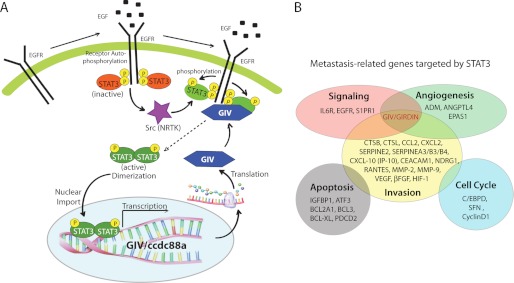FIGURE 7.

Implications of the forward feedback mutual regulation between GIV and STAT3. A, proposed model for the interplay between GIV and STAT3 during wound healing and cancer invasion. Upon ligand stimulation of EGF receptor (EGFR) and other growth factor receptors, inactive STAT3 (red oval) is recruited to the cytoplasmic tail of the activated receptor and subsequently activated (green oval) by phosphorylation at Tyr-705 by receptor and non-receptor tyrosine kinases (purple star). STAT3 dimerizes, enters the nucleus, and activates transcription of GIV gene (ccdc88a). GIV (blue hexagon) enhances receptor-initiated PI3K signals and triggers cytoskeletal rearrangement during wound healing and cancer invasion. GIV also directly binds to the receptor tail (2) and enhances STAT3 activation via its GEF motif, thereby creating a positive/forward feedback loop (interrupted arrow). B, GIV is a multifunctional, direct transcriptional target of STAT3. A schematic representation of various direct transcriptional targets of STAT3 is shown in which each target gene is grouped according to its gene ontology classification. GIV, which is a cytoskeleton-associated protein that has intrinsic enzyme activity (i.e. GEF), has to date been implicated in signal enhancement downstream of multiple RTKs and G protein-coupled receptors (1), angiogenesis (10), and cell invasion (13). Because GIV enhances STAT3 activation, it could regulate the expression of one or more of the genes shown here that are direct targets of STAT3.
